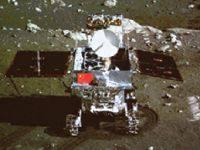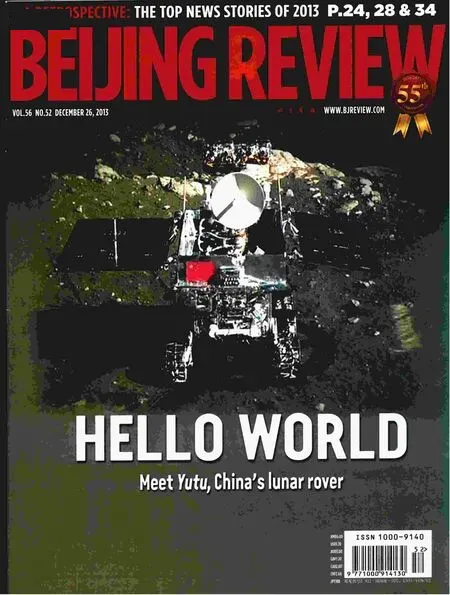CHINA ON THE MOON
2013-04-29ByYuanYuan
By Yuan Yuan

The Chinese lunar probe Change-3 has ini- tiated a new phase of space exploration for mankind after successfully landing on the Earths satellite.
The soft-landing was made at approximately 9:11 p.m. on December 14, making China the third country to do so after the former Soviet Union and the United States. Change-3 was launched on a Long March-3B carrier rocket from the Xichang Satellite Launch Center in southwest Chinas Sichuan Province. The region of the moon that the probe landed on, known as Sinus Iridum, or the Bay of Rainbows, has remained unstudied and untouched by mankind until now.
About seven hours after the landing, at 4:35 a.m. on December 15, Yutu, meaning jade rabbit, the 140-kg lunar rover carried by Change-3, separated from the lander and drove out onto the moons surface, leaving behind tire tracks on the loose lunar soil. A camera on the lander recorded the process and the images were transmitted back to Earth, according to the Beijing Aerospace Control Center.
At 11:42 p.m., after the rover moved to a spot about nine meters north of the lander, they took photographs of each other using the landers landform camera and Yutus panoramic camera.
The color images, transmitted live via a satellite network designed by China, show Yutu proudly brandishing the five-starred red Chinese flag, the first time that it has been taken to an extraterrestrial body.
Ma Xingrui, chief commander of Chinas lunar exploration program, announced that the Change-3 mission was a “complete success,”after the lander and moon rover took pictures of each other.
Previously unseen
“The photographs showed both the lander and the rover are functioning well and at the same time they marked the completion of the soft landing, and the beginning of onsite surveying,”said Pei Zhaoyu, a spokesman for the program.
According to scientists working on the Change-3 mission, six of the eight scientific instruments aboard Yutu and the Change-3s lander have already been activated and have begun observing space, the Earth and the moon, as of December 18.
“Change-3 will study the moons terrain, geological structure, composition, and potentially exploitable resources,” said Zou Yongliao, a scientist with the Chinese Academy of Sciences, adding that the lander will observe the Earths plasmasphere using an extreme-ultraviolet imager.
At the same time, the Change-3s lander, which will conduct exploration at the landing site for one year, will also deploy a telescope that will observe deep space.
“This is the first time mankind has placed a telescope on the moon. The special environment of the moon will enable us to conduct observation that could not be done on the Earth due to the impact of the atmosphere,” said Sun Huixian, deputy chief engineer of Chinas lunar exploration program.
Yutu, which will have a three-month life span, will survey the moons geological structure and surface composition, also looking for natural resources.
On December 15, Yutus radar began tests to determine the constitution of the lunar soil. According to Sun, the radar system attached to the bottom of the rover can scan up to 100 meters beneath the lunar surface.
Sun said that the rover is able to climb slopes of up to 30 degrees and travel at 200 meters per hour, explaining that designers set such a low speed for the vehicle because it has to detect and avoid obstacles.
Using its ability to detect obstructions, the rover will determine the path of least resistance by coupling its onboard navigation systems with remote control.
“Theoretically, Yutu can travel nearly 10 km across the moon,” Sun said. “Engineers set up a laboratory on the Earth to simulate the uneven terrain of the moon and the rover went through extensive testing first.”
The moons temperature ranges from more than 100 degrees Celsius during the day to as low as 180 degrees Celsius below zero at night due to the lack of an atmosphere, presenting another challenge to the rover.
To work properly, the rover has to maintain an internal operating temperature range between 40 degrees Celsius below zero to 50 degrees Celsius above. To achieve this, both the lander and rover are equipped with radioisotope heating units.
Technological breakthroughs
Before Change-3 landed on the moon, 129 lunar explorations had been conducted but only 66 of them succeeded, among which only 13 unmanned soft landings were successfully completed.
The last soft landing took place on August 18, 1976, when the Soviet probe Luna-24 touched down on the moon to collect samples. In the following 37 years, the moon has had nothing land on its surface.
The low success rate tells the difficulties of lunar explorations and landing. China, as a newcomer to the worlds space exploration club, has been adhering to a path of domestically developed innovations.
Compared to Change-1 and Change-2 lunar probes, launched in 2007 and 2010 respectively, 80 percent of Change-3s components and technologies are new, said Sun Zezhou, chief designer of the lunar probe.
Launched in January 2004, Chinas lunar exploration program includes orbiting, landing and returning to the Earth.
After the Change-3 mission, Chinas lunar exploration program will enter a new stage of unmanned automatic sampling and return when it launches Change-5, which will be an even more difficult endeavor with its own new challenges.
“The programs third phase will be more difficult because many technological breakthroughs must be made first, such as takeoff from the lunar surface, sampling encapsulation, rendezvous and docking in lunar orbit, and high-speed Earth re-entry, which are all new to China,” said Wu Zhijian, a spokesman for the State Administration of Science, Technology and Industry for National Defense, at a press conference in Beijing on December 16.
As the backup probe for Change-3, Change-4 will also be adapted to test technologies to be used by Change-5, according to Wu.
It was revealed that China plans to launch Change-5 in 2017, which is expected to bring back up to 2kg of material from the lunar surface.
Researchers from the U.S. National Aeronautics and Space Administration have described Change-3s operations on the moon as “a new scientific opportunity that could potentially enhance studies and observations of the lunar atmosphere.”
Global cooperation
“The Change-3 details tell me that the United States now absolutely must start communicating with the Chinese about lunar cooperation,”said retired U.S. astronaut Buzz Aldrin, who was the second man to set foot on the moon after Neil Armstrong, in an interview with Aerospace America magazine.
Russian astronaut Vladimir Kovalenok said that the Chinese lunar program is on the right track and China can continue its path while taking into account the pros and cons of the lunar programs of the United States and the former Soviet Union.
“China is now a pioneer in this field, and its lunar missions will be a catalyst for lunar explorations by other countries, as the moon can serve as a basis for a jump on journeys to more distant places in the solar system,”Kovalenok said.
“The European Space Agency (ESA) and China have recently signed a mutual cross support agreement that implies that the ESA can provide support to a Chinese mission through our deep space network (Estrack),” said Karl Bergquist, Administrator of ESAs International Relations Department.
“But the contrary could also be possible, i.e. that ESA would make requests to China to use Chinese antennas for an ESA mission. This has not yet happened, but I am sure it will happen in the next few years,” Bergquist told Chinas Xinhua News Agency.
“This is a sign of the close relations that exists between the ESA and the Chinese space authorities,” Bergquist added.
At the December 16 press conference, Wu said that China is always positive about international cooperation in lunar exploration.“We have had great cooperation with other countries and international organizations during previous missions,” he noted.
Data collected through Change-1 and Change-2 probes are available to scientists across the globe, according to Wu. He also revealed that China shared information collected by Change-1 with the ESA, and an ESA aerospace control center as well as three of its telecommand telemetry control stations took part in the Change-3 mission.
“In the next stage of Chinas lunar exploration program, there will be more international cooperation,” Wu said.
